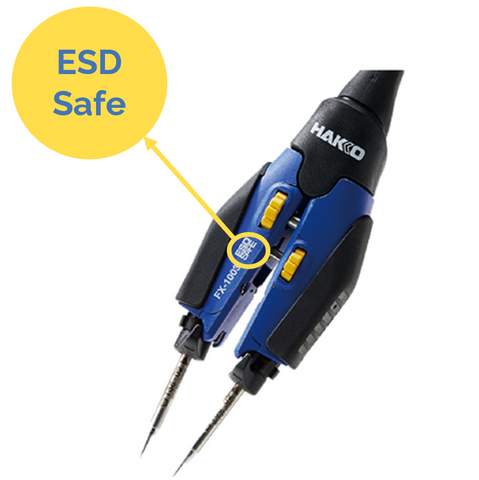Dangers of Electrostatic Discharge (ESD)

ESD is one of the most significant factors contributing to damage and failure in electronic components as it is not always visible to the naked eye. It takes a minimum voltage of 3000 for a human body to perceive a static discharge, which is much higher than the damage threshold for electronic components at 10 volts.
ESD damage is usually caused by 3 types of events:
 |
Discharge to the Device It occurs when the static charges accumulated in one’s body discharge as he/she makes a contact with an electrostatic-sensitive (ESDS) device. A similar discharge can occur from a charged object, such as a metallic tool or fixture. |
 |
Discharge from the Device The transfer of charge from an ESDS device can also occur as static charges accumulate on the ESDS device itself through contact and separation with packaging materials, work surfaces, or machine surfaces. |
 |
Field-Induced Charge An electrostatic field exists in the region surrounding an object when it becomes electrostatically charged. If an ESDS device is placed in an electrostatic field, a charge may be induced on the device. If the device is then momentarily grounded while within the electrostatic field, a transfer of charge from the device occurs as an ESD event. If the device is removed from the region of the electrostatic field and grounded again, a second ESD event will occur as charge (of opposite polarity from the first event) is transferred from the device. |
Damage caused by an ESD event can be classified in 2 ways:
 |
Catastrophic Failure An ESD event can cause a metal melt, junction breakdown or oxide failure in an electronic device, resulting permanent damage to electronic components, and the device’s ability to function. Only when the device is tested can such failures be detected. If the ESD event occurs after the test, the damage will go undetected until the device fails in operation. |
 |
Latent Defect A latent defect, on the other hand is more difficult to detect. It occurs when an ESDS object is partially degraded after being exposed to an ESD event. While it may continue to perform its intended function, it may experience intermittent or permanent failures in future. Repairing such failures is usually costly, and in some cases, they may put people in danger. |
If it is not properly controlled, ESD damage can have a major impact on output yield, product quality and reliability, and company's profitability. Understanding what causes ESD to occur is the first step towards prevention.
ESD-SAFE HAKKO PRODUCTS

Most Hakko products are ESD-safe certified - they are made with ESD-safe materials or are able to be grounded safely to reduce ESD. Simply look out for the "ESD-Safe" logo on our products!
The devices are grounded properly and the electrical potential between the tips and the ground does not exceed two millivolts at any time. As for the construction of the devices, ESD safe materials are used. Components that are exempted from ESD requirements which include fuses, power cords, power receptacles and more are insulative for electrical safety.
HAKKO ESD CONTROL

Hakko also has a wide range of ESD control and testing products to allow users to test for static potential and prevent it in time.
- 442B ESD Safe Wrist Strap
- FG-450 Static Level Meter
- FG-465 Shoe Tester
- FG-470 Wrist Strap Tester
- Hakko B3586 Body Charging Measurement Plate (For FG-450)